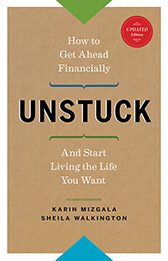By Kathryn Mandelcorn, FMA
 You are not born with a set of values around money. The blueprint for your financial habits and behaviors is drawn by the experiences and significant people in your past and present. The current state of your finances, good or not so good, likely has less to do with your income and expenses than it does with your internal, emotional blueprint.
You are not born with a set of values around money. The blueprint for your financial habits and behaviors is drawn by the experiences and significant people in your past and present. The current state of your finances, good or not so good, likely has less to do with your income and expenses than it does with your internal, emotional blueprint.
Don’t believe me? I started my work as a Money Coach because of a need that was not being met by people seeking traditional financial advice: the need for financial peace. I saw millionaires living paycheck to paycheck. I saw people consolidate their debts or refinance their home only to be in debt again a year later. I saw people with enough assets to get them through retirement and provide for their children but still could not sleep at night for fear of losing everything.
You may have been fortunate enough to receive a blueprint that matches the financial home you are trying to build. If so, you are probably working a plan and feeling pretty good about it even if you haven’t yet achieved all your goals. But if you are feeling stuck, stressed, or worried around money, you may be working from a blueprint that doesn’t support your aspirations. Fortunately a blueprint is changeable, but we can only change it when we become aware that it exists.
There are three important steps to changing your internal blueprint.
(If you are in a relationship it would be excellent for you both go through this exercise, so you can understand the challenges and emotions you each bring to the achievement of shared goals. But even if you partner isn’t interested, understanding your own blueprint and being aware that your partner has an unconscious blueprint, can help you navigate money conversations from a better place).
Step 1. Become mindful. Mindful of how you speak about money, your internal and external conversations. Is there a lot of negativity? Do you say things like: “There is never enough money” or “I try but I just can’t save.” So many clients are surprised by the language they hear when they stop to listen.
Step 2. Look at the past that created the blueprint. Write a history of your family’s habits and behaviors around money. Go back as far as you can. (This exercise is designed to give you awareness not to make you feel bad or blame anyone). Reflect on it. What story does it tell? Is it a fortunate, happy, tragic or sad story? Money can make us feel envious, elated, greedy, worried, liberated or depressed. Do you see the root of those feelings in your family history?
Step 3. Who are you now? What are your values? Do you feel you deserve wealth? Where are your conscious goals in conflict with the unconscious emotional blueprint you discovered in step two? Fortunately, that blueprint isn’t unconscious anymore. You can make changes. Changes are about little shifts that make a big difference. For instance, you are more likely to save when you stop telling yourself you can’t.
Recently a couple I’ve been working with began to see a change in their awareness around cash flow. They emailed me to say they had been at the hardware store and came across a BBQ that they decided they wanted. They hadn’t gone to the hardware store to buy a BBQ. They stood there looking at it and asked each other: “Where will the money come from to pay for this?” it sounds simple but it was the first time they had ever been money conscious enough to ask this question. They left the store and didn’t buy the BBQ. They saved themselves from a $500 purchase that would have hindered their goal to pay off their debts and continue their education. They were ecstatic.
We build our financial future every day. If you aren’t happy with the state of your financial house, create a new blueprint that inspires and empowers you.



